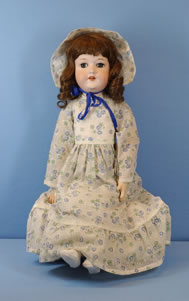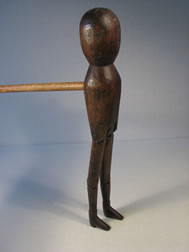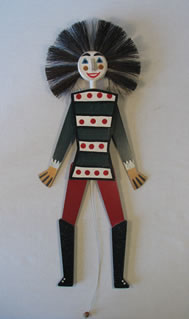Collecting social history
The Social History collection reflects the lives of Warwickshire people over the last 300 years.
Many items have been donated by individuals – one of our youngest donors is Henry, who you can find out more about below. Visitors to the museum often leave money in the donations box. This helps us purchase items which are seen as locally important, such as the Cyril Hobbins collection of wooden toys.
Joy Robinson
Many of the objects in the Doll and Toy collection once belonged to a private collector, Joy Robinson.

An important part of collecting dolls for Joy was sharing her interest with others, and from 1955 she displayed her collection in Oken’s House, Warwick. It became the ‘Doll Museum’ and as the collection grew it gained an international reputation.
Joy continued to run the Doll Museum until her death in 1978. The collection then passed to her sister Peggy who cared for the museum until 1987. In 1987 the Warwickshire Museum bought the collection, with the generous help of organisations like the King Henry VIII Endowed Trust. In September 2004, the Doll Museum was closed and the collection was removed for careful cleaning and conservation. Joy’s collection still makes up a large part of the Doll and Toy collection, and items are often displayed at St. John’s House Museum, Warwick.
The images below are of a doll from the Joy Robinson collection. The porcelain head doll was made in c.1925 by the German manufacturer Armand Marseille. Her head is made of a material known as bisque, or unglazed porcelain, and her body is made from composition (a mix of paper and wood pulp). The doll’s legs are easy to move and play with. They are also made from composition and have ball and socket joints.
Cyril Hobbins

Jig doll
In 2008, Warwickshire Museum Service acquired a large collection of wooden toys and games. The toys had been collected by local toy maker Cyril Hobbins, who had used them as inspiration for making his own toys.
Cyril’s collection grew from a great interest in, and love of, wooden toys. He was also concerned that, with the growth of plastic and electronic toys, the humble wooden toy might vanish altogether.

Jumping Jack doll
The collection includes approximately 500 toys and games and 200 books about toys and toy making.
Cyril has long been a friend of the Warwickshire Museum Service, and has produced some wonderful replica toys for use by school children in activity sessions, and for visitors to touch and play with in the galleries.
Cyril was very keen to find a good home for his collection. He was delighted that the Warwickshire Museum was able to take it, ensuring that it would be a resource for future generations.
The two toys shown here are a spiky haired ‘Jumping-Jack’, c1950 – 1970, and a dancing ‘Jig-doll’, c1830 – 1900. Both are moving toys – by pulling the Jumping-Jack’s string, the arms and legs move up and down. The Jig-doll’s legs are jointed and move when the stick is moved.
Henry, aged 5
Many of the items in the Social History collection come from individuals. They could be people ‘downsizing’ before moving house or childhood toys no longer wanted. Sometimes people leave things in their will.
However, we can’t collect everything that we are offered! If the object is in poor condition or is the same as something we already have, then we have to say ‘no thank you’.
The Museum Service does not just collect “old things” from the past for the Social History collection. We also actively collect modern objects.
Henry is one of our youngest donors. He donated several of his toys including ‘Bob the Builder’ and ‘Fireman Sam’.
Anyone of any age can donate objects they own to the museum, but if, like Henry, they are under 18, they will need parental or a guardian’s consent.




